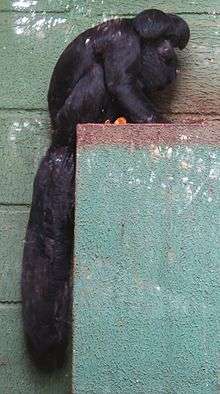Black bearded saki
| Black bearded saki[1] | |
|---|---|
 | |
| Scientific classification | |
| Kingdom: | Animalia |
| Phylum: | Chordata |
| Class: | Mammalia |
| Order: | Primates |
| Suborder: | Haplorhini |
| Infraorder: | Simiiformes |
| Family: | Pitheciidae |
| Genus: | Chiropotes |
| Species: | C. satanas |
| Binomial name | |
| Chiropotes satanas (Hoffmannsegg, 1807) | |
 | |
| Black bearded saki range | |

The black bearded saki (Chiropotes satanas) is a species of bearded saki, a type of New World monkey, one of five remaining monkeys of their kind. The scientific name Chiropotes means "hand-drinker" as they have been observed using their hands as ladles for scooping water into their mouths. This behavior is thought to be way of maintaining and protecting their magnificent beards.[3]
Distribution and Habitat
This critically endangered species is endemic to the far eastern Amazon in Brazil, it being restricted to a relatively small region from the Tocantins River in Pará east to around the Grajaú River in Maranhão (similar to the range of the equally threatened Kaapori capuchin).
Anatomy and Morphology
They can be identified by their thick black hair, distinctive beard that shapes the face, and a bushy fox-like tail. They can have some yellowish brown highlights around the back and shoulders. There are some gender differences as the males tend to be slightly larger than females and also have a bulging foehead.[4] They formerly included the red-backed, brown-backed and Uta Hick's bearded saki as subspecies or taxonomical insignificant variations (in which case the 'combined' species simply was called the bearded saki), but based on colour of pelage, karyotype, and molecular analysis it has been recommended treating these as separate species.[5][6] The black bearded saki is the only dark-nosed species of bearded saki with a blackish back, though some females and young have a paler, brownish back.[7]
Behavior
As an infant the monkeys can be seen using their tail to grasp things but lose the ability as the primate gets older.[8] They are very social animals commonly grooming and playing with one another, even with those of other species [9] and can be found in groups of around 30 individuals. [10] The Black Bearded Saki is a known frugivore and a specialist seed predator spending a majority of their time foraging for fruits and seeds as well as insects. [11] They also use their strong canine teeth to crack open hard shells of fruits and nuts enabling them to access the unripen young seeds in the fruits. Bearded sakis have a gestation period of 5 months and produce one young at a time. They don't become sexually mature until 4 years old and havean expected lifespan of 18 years. [12]
Conservation
Just over the last few decades urbanization has brought with it highways, agriculture, and dams creating an influx in habitat fragmentation, habitat destruction and hunting pressure. [13] Habitat fragmentation is rising as secondary roads increase and people move closer to the forests. Along with an influx of people the amount of agriculture required to support the area increases, increases pressure for deforestation. Finally they also face a hunting problem for their bushmeat and their tails used as dusters. Habitat conservation is of top priority as this species has a particularly small range are considered the most endangered primate in the Amazon and already locally extinct in a large portion of their original range.[14]
References
- ↑ Groves, C.P. (2005). Wilson, D.E.; Reeder, D.M., eds. Mammal Species of the World: A Taxonomic and Geographic Reference (3rd ed.). Baltimore: Johns Hopkins University Press. p. 147. ISBN 0-801-88221-4. OCLC 62265494.
- ↑ Veiga, L. M.; Silva Jr., J. S.; Ferrari, S. F. & Rylands, A. B. (2008). "Chiropotes satanas". The IUCN Red List of Threatened Species. 2008: e.T39956A10297662. doi:10.2305/IUCN.UK.2008.RLTS.T39956A10297662.en. Retrieved 11 January 2018. Database entry includes justification for why this species is critically endangered
- ↑ "Bearded saki (Chiropotes satanas)". Wildscreen Arkive. Retrieved 30 April 2018.
- ↑ "Bearded saki (Chiropotes satanas)". Wildscreen Arkive. Missing or empty
|url=(help) - ↑ Silva Jr., J. S. and Figueiredo, W. M. B. (2002). Revisão sistemática dos cuxiús, gênero Chiropotes Lesson, 1840 (Primates Pithecidae). Livro de Resumos do XO. Congresso da Sociedade Brasileira de Primatologia, Amazônia – A Última Fronteira: 21. Belém, Brazil.
- ↑ Bonvicino, C. R., Boubli, J. P., Otazú, I. B., Almeida, F. C., Nascimento, F. F., Coura, J. R., & Seuánez, H. N. (2003). Morphologic, karyotypic, and molecular evidence of a new form of Chiropotes (primates, pitheciinae). American Journal of Primatology. 61(3): 123-33.
- ↑ Veiga, L. V. (2006).(in Portuguese) Ecologia e comportamenta do cuxiú-preto (Chiropotes satanas) na paisagem fragmentada da Amazônoa oriental. Archived July 6, 2011, at the Wayback Machine. Ph.D. thesis. Universidade Federal do Pará, Brazil.
- ↑ "Bearded Saki". Wildscreen Arkive. Retrieved 30 April 2018.
- ↑ Silva, Suleima (2009). "Behavior Patterns of Southern Bearded Sakis (Chiropotes satanas) in the Fragmented Landscape of Eastern Brazilian Amazonia". American Journal of Primatology. 71: 1–7.
- ↑ "Bearded saki (Chiropotes satanas)". Wildscreen Arkive. Retrieved 30 April 2018.
- ↑ Norconk, Marilyn (May 2016). "Bearded Saki Feeding Strategies on an Island in Lago Guri, Venezuela". American Journal of Primatology. 78 (5): 507–522. Retrieved 29 April 2018.
- ↑ "Bearded saki (Chiropotes satanas)". Wildscreen Arkive. Retrieved 30 April 2018.
- ↑ "Chiropotes Satanas". Retrieved 29 April 2018.
- ↑ "Bearded saki (Chiropotes satanas)". Wildscreen Arkive. Retrieved 30 April 2018.
| Wikispecies has information related to Black Bearded Saki |
External links
